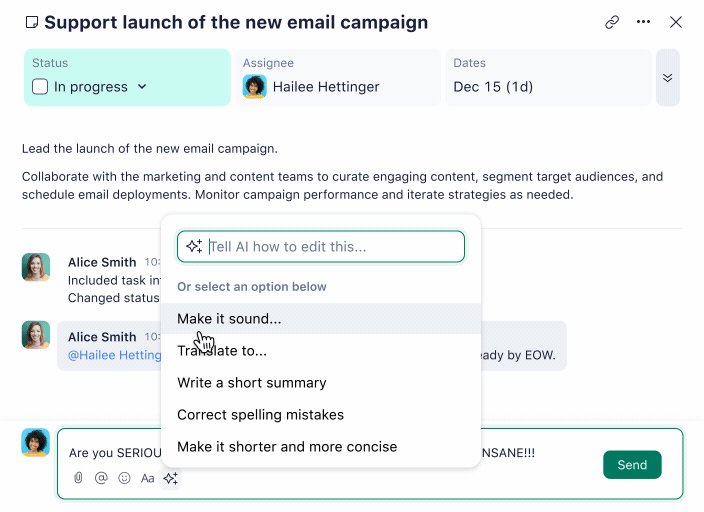Key takeaways:
- How did Varsity Yearbook transform its workflows? Varsity Yearbook unified processes with Wrike, cutting proofing turnaround times by 42% and promoting organic adoption.
- What was Jellyfish’s approach to improving collaboration? Jellyfish eliminated ineffective spreadsheets by consolidating tools into Wrike, creating a centralized source of truth for better decision making.
- How did Syneos Health scale its Wrike implementation? Starting with 300 users, Syneos Health expanded to over 2,400 users and managed 47,000 projects, significantly improving transparency and ROI tracking.
- What are key benefits of integrating AI in daily workflows? Teams save time with AI-driven comment summaries, automated routing, and efficient searches, significantly enhancing productivity.
- What leadership principles should guide AI adoption? Embed AI in existing workflows, empower change agents to drive adoption, and quantify results to build momentum and secure buy-in.
At Wrike, we’ve always believed that the best innovation stories come from our customers.
During our first-ever Wrike AI Demo Day, I had the privilege of hosting a panel with three exceptional leaders who are transforming how their organizations work. Their experiences prove something we’ve known all along: Wrike is far beyond the AI hype. We’re at the center of everyday productivity.
I want to share highlights from these three customer success stories and dig into what other organizations can learn from them.
From disruption to unified workflows
One such customer was Ali Moses of Varsity Yearbook. Her team went from using a free Wrike account to running critical workflows across their business, a transformation that was accelerated by the pandemic. Wrike helped unify scattered processes, cut proofing turnaround times by 42%, and replaced siloed information with a single, accessible source of truth.
What struck me most about her story was Ali’s emphasis on ease of adoption. Wrike didn’t just get deployed — it spread organically because it worked.
Killing the spreadsheet (for the better)
James Ball from Jellyfish had a mission — to “kill the spreadsheet,” not because spreadsheets don’t have value, but because they were being used for things they were never designed to do.
By consolidating disconnected tools into Wrike, Jellyfish gained visibility, improved efficiency, and built a culture of collaboration across teams. James put it best: “Wrike turned a patchwork of processes into a single source of truth — and that has been a game changer for decision making and alignment.”
Scaling to 47,000 projects (and counting)
When Sherrie Besecker rolled out Wrike at Syneos Health in 2018, she started with a simple minimum viable product for 300 users. Sherrie explained that “today, Wrike supports over 2,400 users, 47,000 projects, and 1 million tasks across Syneos Health’s global enterprise.”
Sherrie’s team uses Wrike to reduce manual work, improve transparency, and measure process adoption. Most importantly, they can now prove ROI through data — showing leadership exactly where Wrike drives value.
AI in the real world: Measurable time savings
All three customers are leveraging Wrike AI to make their teams faster and more effective:
- AI comment summaries that distill more than 30+ message threads into clear action items
- Automation that eliminates manual routing and frees up teams to focus on high-value work
- AI search and knowledge base integration that surfaces the right standard operating procedure in seconds, even in large, distributed teams
These aren’t experiments or side projects; they’re embedded in daily workflows, saving minutes and hours that add up to measurable gains.

Culture change: AI as an enhancer, not a threat
A recurring theme in our discussion was leadership’s role in embracing AI as a productivity enhancer, not a disruptor.
- Syneos Health hosts monthly AI-focused sessions, spotlighting real use cases from across the company.
- Varsity Yearbook embraces AI because it can quickly make information accessible to everyone internally, improving everyday productivity and fostering greater creativity.
- Jellyfish uses Wrike Copilot to prioritize work based on dependencies — a smarter, more context-driven approach than simply reacting to overdue tasks.
The competitive edge
Some companies are still chasing headlines with flashy AI promises. Our customers show why Wrike is different: We deliver AI that works, today, for the workflows that matter most.
This is the real differentiator, not launching features for features’ sake, but providing tools that help customers move faster, reduce friction, and amplify the work only humans can do.
Three lessons for leaders
From our conversation during AI Demo Day, three leadership principles stood out to me. They’re relevant to any organization adopting AI at scale:
- Embed AI where work happens
Avoid isolated pilots and connect experimentation to results. Integrate AI directly into the systems and workflows your teams already use, so value is felt immediately. - Empower change agents
Identify and equip champions across the organization who can model best practices and drive adoption. - Quantify and share the wins
Track time savings, quality improvements, and deliver workflow efficiency — and make those metrics visible to build momentum and secure leadership buy-in.
Looking ahead: Collaborate 2025
The stories shared in this Wrike AI Demo Day panel are just the beginning. At Wrike Collaborate 2025, we’ll showcase even more ways customers are using smarter workflows, contextual AI, and user-centric innovation to drive lasting impact. I’d love for you to join us! Register today and save your spot for October to hear directly from Wrike’s powerhouse product innovators, some of our most successful customers, and industry thought leaders.







